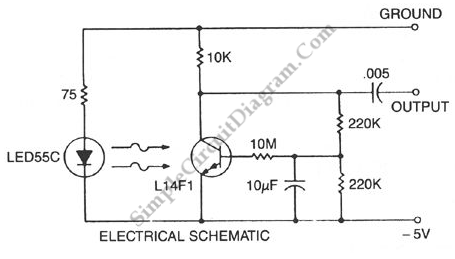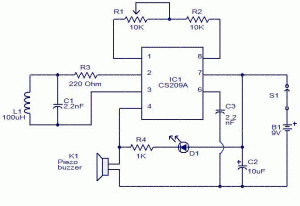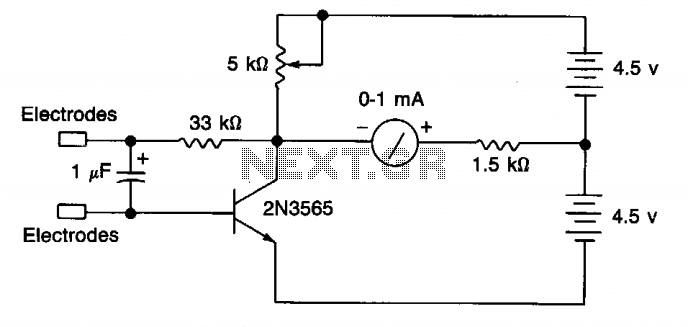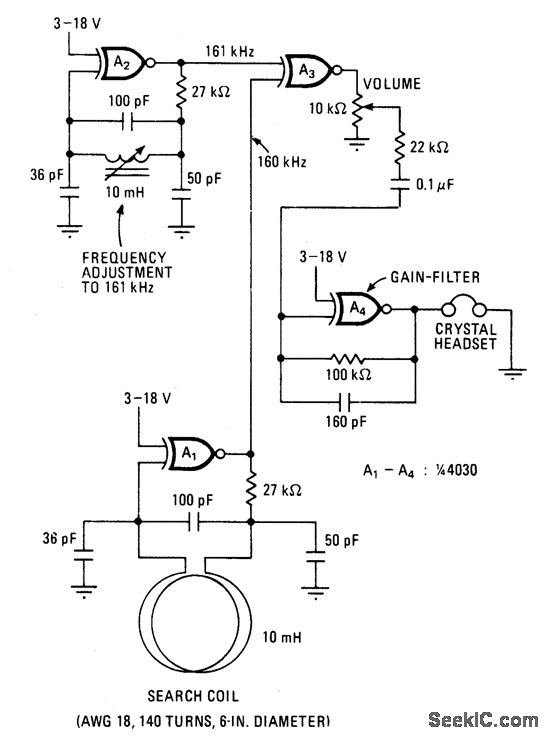
Gamma-Photon Radiation Detector

A PIN photodiode, four low-noise operational amplifiers, and a comparator are utilized to detect individual photons of gamma radiation. The schematic, design considerations, and component selection are discussed.
The circuit design incorporates a PIN photodiode, which is a semiconductor device that converts light into an electrical current. When exposed to gamma radiation, the photodiode generates a measurable photocurrent proportional to the intensity of the incoming photons. The low-noise operational amplifiers are essential for amplifying the small signals produced by the photodiode. Their low noise characteristics ensure that the system can detect even the faintest signals without significant interference from background noise.
The output from the photodiode is fed into the first operational amplifier, which is configured in a transimpedance amplifier configuration. This setup converts the photocurrent into a voltage signal, allowing for easier processing. Following this, the signal is passed through additional low-noise operational amplifiers to further amplify the voltage while maintaining signal integrity.
The comparator is employed to determine whether the amplified signal exceeds a predefined threshold, indicating the presence of a photon. This threshold can be adjusted based on the specific application requirements, allowing for flexibility in detection sensitivity. The output of the comparator can be used to trigger additional circuits or systems, such as a digital readout or data acquisition system.
In summary, the circuit is designed to provide a reliable and sensitive method for detecting individual photons of gamma radiation, leveraging the properties of the PIN photodiode and low-noise operational amplifiers, along with a comparator for signal processing. The careful selection and arrangement of components are crucial for optimizing performance and ensuring accurate detection in various applications, including medical imaging, radiation monitoring, and scientific research.A PIN photodiode, four low-noise op amps and a comparator are used to detect individual photons of gamma radiation. The schematic, design considerations and component selection are discussed.. 🔗 External reference
The circuit design incorporates a PIN photodiode, which is a semiconductor device that converts light into an electrical current. When exposed to gamma radiation, the photodiode generates a measurable photocurrent proportional to the intensity of the incoming photons. The low-noise operational amplifiers are essential for amplifying the small signals produced by the photodiode. Their low noise characteristics ensure that the system can detect even the faintest signals without significant interference from background noise.
The output from the photodiode is fed into the first operational amplifier, which is configured in a transimpedance amplifier configuration. This setup converts the photocurrent into a voltage signal, allowing for easier processing. Following this, the signal is passed through additional low-noise operational amplifiers to further amplify the voltage while maintaining signal integrity.
The comparator is employed to determine whether the amplified signal exceeds a predefined threshold, indicating the presence of a photon. This threshold can be adjusted based on the specific application requirements, allowing for flexibility in detection sensitivity. The output of the comparator can be used to trigger additional circuits or systems, such as a digital readout or data acquisition system.
In summary, the circuit is designed to provide a reliable and sensitive method for detecting individual photons of gamma radiation, leveraging the properties of the PIN photodiode and low-noise operational amplifiers, along with a comparator for signal processing. The careful selection and arrangement of components are crucial for optimizing performance and ensuring accurate detection in various applications, including medical imaging, radiation monitoring, and scientific research.A PIN photodiode, four low-noise op amps and a comparator are used to detect individual photons of gamma radiation. The schematic, design considerations and component selection are discussed.. 🔗 External reference





